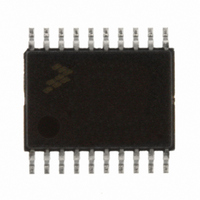MC9S08EL16CTJ Freescale Semiconductor, MC9S08EL16CTJ Datasheet - Page 255

MC9S08EL16CTJ
Manufacturer Part Number
MC9S08EL16CTJ
Description
MCU 16KB FLASH SLIC 20TSSOP
Manufacturer
Freescale Semiconductor
Series
HCS08r
Datasheet
1.DEMO9S08EL32.pdf
(356 pages)
Specifications of MC9S08EL16CTJ
Core Processor
HCS08
Core Size
8-Bit
Speed
40MHz
Connectivity
I²C, LIN, SCI, SPI
Peripherals
LVD, POR, PWM, WDT
Number Of I /o
16
Program Memory Size
16KB (16K x 8)
Program Memory Type
FLASH
Eeprom Size
512 x 8
Ram Size
1K x 8
Voltage - Supply (vcc/vdd)
2.7 V ~ 5.5 V
Data Converters
A/D 12x10b
Oscillator Type
External
Operating Temperature
-40°C ~ 85°C
Package / Case
20-TSSOP
Processor Series
S08EL
Core
HCS08
Data Bus Width
8 bit
Data Ram Size
1 KB
Interface Type
SCI, SPI, I2C, SLIC
Maximum Clock Frequency
200 KHz
Number Of Programmable I/os
16
Number Of Timers
2
Operating Supply Voltage
5.5 V
Maximum Operating Temperature
+ 85 C
Mounting Style
SMD/SMT
3rd Party Development Tools
EWS08
Development Tools By Supplier
DEMO9S08EL32AUTO, DEMO9S08EL32
Minimum Operating Temperature
- 40 C
On-chip Adc
10 bit, 12 Channel
For Use With
DEMO9S08EL32 - BOARD DEMO FOR 9S08 EL MCUDEMO9S08EL32AUTO - DEMO BOARD EL32 AUTO
Lead Free Status / RoHS Status
Lead free / RoHS Compliant
- Current page: 255 of 356
- Download datasheet (9Mb)
14.2.4
This register has eight read-only status flags. Writes have no effect. Special software sequences (which do
not involve writing to this register) are used to clear these status flags.
Freescale Semiconductor
Reset
Field
RWU
SBK
TE
RE
3
2
1
0
W
R
TDRE
SCI Status Register 1 (SCIxS1)
Transmitter Enable
0 Transmitter off.
1 Transmitter on.
TE must be 1 in order to use the SCI transmitter. When TE = 1, the SCI forces the TxD pin to act as an output
for the SCI system.
When the SCI is configured for single-wire operation (LOOPS = RSRC = 1), TXDIR controls the direction of
traffic on the single SCI communication line (TxD pin).
TE also can be used to queue an idle character by writing TE = 0 then TE = 1 while a transmission is in progress.
Refer to
When TE is written to 0, the transmitter keeps control of the port TxD pin until any data, queued idle, or queued
break character finishes transmitting before allowing the pin to revert to a general-purpose I/O pin.
Receiver Enable — When the SCI receiver is off, the RxD pin reverts to being a general-purpose port I/O pin. If
LOOPS = 1 the RxD pin reverts to being a general-purpose I/O pin even if RE = 1.
0 Receiver off.
1 Receiver on.
Receiver Wakeup Control — This bit can be written to 1 to place the SCI receiver in a standby state where it
waits for automatic hardware detection of a selected wakeup condition. The wakeup condition is either an idle
line between messages (WAKE = 0, idle-line wakeup), or a logic 1 in the most significant data bit in a character
(WAKE = 1, address-mark wakeup). Application software sets RWU and (normally) a selected hardware
condition automatically clears RWU. Refer to
0 Normal SCI receiver operation.
1 SCI receiver in standby waiting for wakeup condition.
Send Break — Writing a 1 and then a 0 to SBK queues a break character in the transmit data stream. Additional
break characters of 10 or 11 (13 or 14 if BRK13 = 1) bit times of logic 0 are queued as long as SBK = 1.
Depending on the timing of the set and clear of SBK relative to the information currently being transmitted, a
second break character may be queued before software clears SBK. Refer to
Queued
0 Normal transmitter operation.
1 Queue break character(s) to be sent.
1
7
Section 14.3.2.1, “Send Break and Queued
Idle” for more details.
= Unimplemented or Reserved
MC9S08EL32 Series and MC9S08SL16 Series Data Sheet, Rev. 3
TC
1
6
Table 14-4. SCIxC2 Field Descriptions (continued)
Figure 14-8. SCI Status Register 1 (SCIxS1)
RDRF
0
5
IDLE
Section 14.3.3.2, “Receiver Wakeup
0
4
Description
Idle” for more details.
OR
3
0
Serial Communications Interface (S08SCIV4)
NF
0
2
Section 14.3.2.1, “Send Break and
Operation” for more details.
FE
0
1
PF
0
0
257
Related parts for MC9S08EL16CTJ
Image
Part Number
Description
Manufacturer
Datasheet
Request
R
Part Number:
Description:
Manufacturer:
Freescale Semiconductor, Inc
Datasheet:
Part Number:
Description:
Manufacturer:
Freescale Semiconductor, Inc
Datasheet:
Part Number:
Description:
Manufacturer:
Freescale Semiconductor, Inc
Datasheet:
Part Number:
Description:
Manufacturer:
Freescale Semiconductor, Inc
Datasheet:
Part Number:
Description:
Manufacturer:
Freescale Semiconductor, Inc
Datasheet:
Part Number:
Description:
Manufacturer:
Freescale Semiconductor, Inc
Datasheet:
Part Number:
Description:
Manufacturer:
Freescale Semiconductor, Inc
Datasheet:
Part Number:
Description:
Manufacturer:
Freescale Semiconductor, Inc
Datasheet:
Part Number:
Description:
Manufacturer:
Freescale Semiconductor, Inc
Datasheet:
Part Number:
Description:
Manufacturer:
Freescale Semiconductor, Inc
Datasheet:
Part Number:
Description:
Manufacturer:
Freescale Semiconductor, Inc
Datasheet:
Part Number:
Description:
Manufacturer:
Freescale Semiconductor, Inc
Datasheet:
Part Number:
Description:
Manufacturer:
Freescale Semiconductor, Inc
Datasheet:
Part Number:
Description:
Manufacturer:
Freescale Semiconductor, Inc
Datasheet:
Part Number:
Description:
Manufacturer:
Freescale Semiconductor, Inc
Datasheet:










